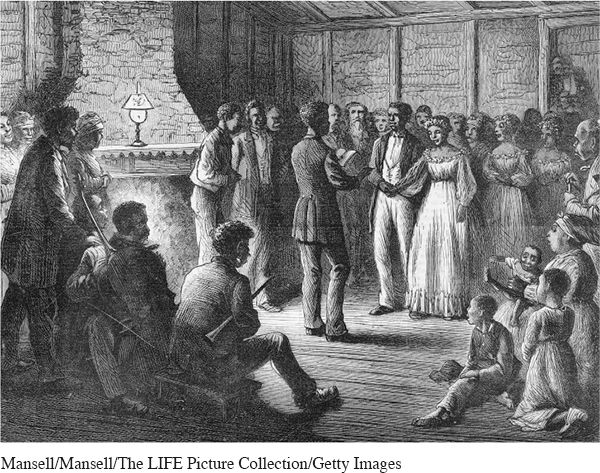Reuniting Families Torn Apart by Slavery
The first priority for many newly freed blacks was to reunite families torn apart by slavery. Men and women traveled across the South to find family members. Well into the 1870s and 1880s, parents ran advertisements in newly established black newspapers, providing what information they knew about their children’s whereabouts and asking for assistance in finding them. Milly Johnson wrote to the Freedmen’s Bureau in March 1867, after failing to locate the five children she had lost under slavery. She finally located three of them, but any chance of discovering the whereabouts of the other two disappeared because the records of the slave trader who purchased them burned during the war. Despite such obstacles, thousands of slave children were reunited with their parents in the 1870s.
Husbands and wives, or those who considered themselves as such despite the absence of legal marriage under slavery, also searched for each other. Those who lived on nearby plantations could now live together for the first time. Those whose spouse had been sold to distant plantations had a more difficult time. They wrote (or had letters written on their behalf) to relatives and friends who had been sold with their mate; sought assistance from government officials, churches, and even their former masters; and traveled to areas where they thought their spouse might reside.
These searches were complicated by long years of separation and the lack of any legal standing for slave marriages. In 1866 Philip Grey, a Virginia freedman, located his wife, Willie Ann, and their daughter Maria, who had been sold away to Kentucky years before. Willie Ann was eager to reunite with her husband, but in the years since being sold, she had remarried and borne three children. Her second husband had joined the Union army and was killed in battle. When Willie Ann wrote to Philip in April 1866, she explained her new circumstances, concluding: “If you love me you will love my children and you will have to promise me that you will provide for them all as well as if they were your own. . . . I know that I have lived with you and loved you then and love you still.”

Most black spouses who found each other sought to legalize their relationship. A superintendent for marriages for the Freedmen’s Bureau in northern Virginia reported that he gave out seventy-nine marriage certificates on a single day in May 1866. In another case, four couples went right from the fields to a local schoolhouse, still dressed in their work clothes, where the parson married them.
Of course, some former slaves hoped that freedom would allow them to leave unhappy relationships. Having never been married under the law, couples could simply separate and move on. Complications arose, however, if they had children. In Lake City, Florida, in 1866, a Freedmen’s Bureau agent asked his superiors for advice on how to deal with Madison Day and Maria Richards. They refused to legalize the relationship forced on them under slavery, but both sought custody of their three children. As with white couples in the mid-nineteenth century, the father was granted custody on the assumption that he had the best chance of providing for the children financially.
Exploring American HistoriesPrinted Page 451
Exploring American Histories Value EditionPrinted Page 333
Chapter Timeline